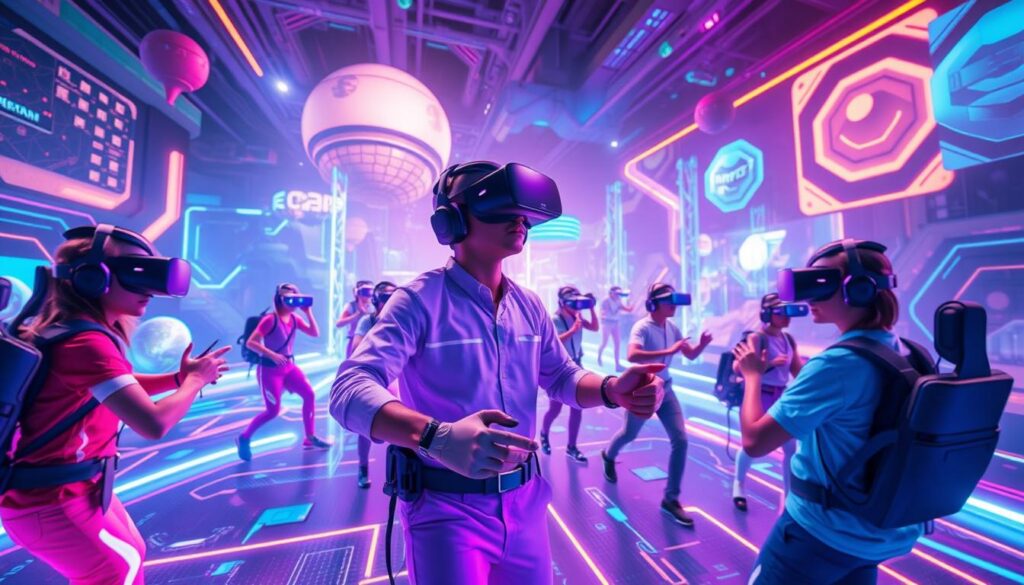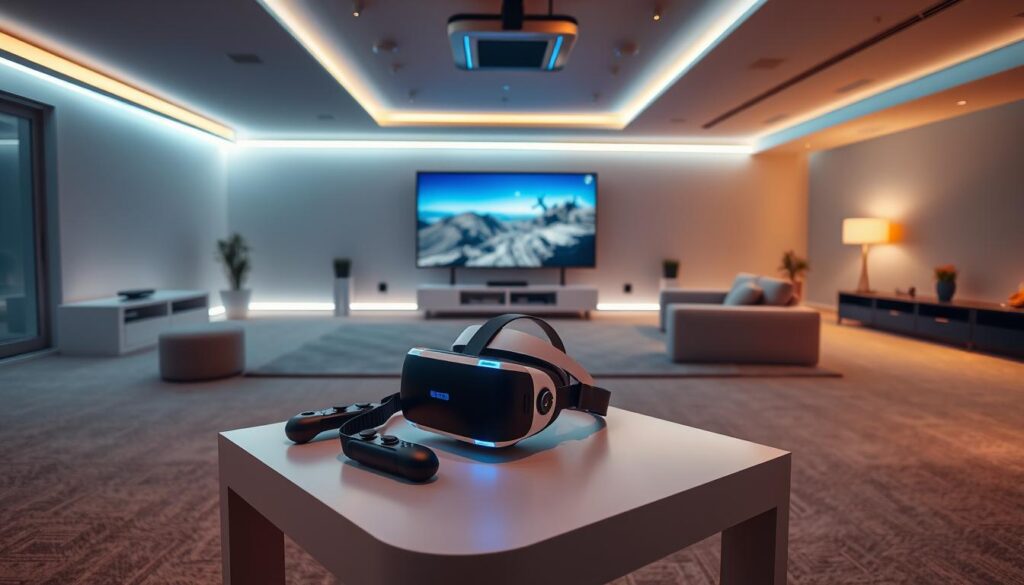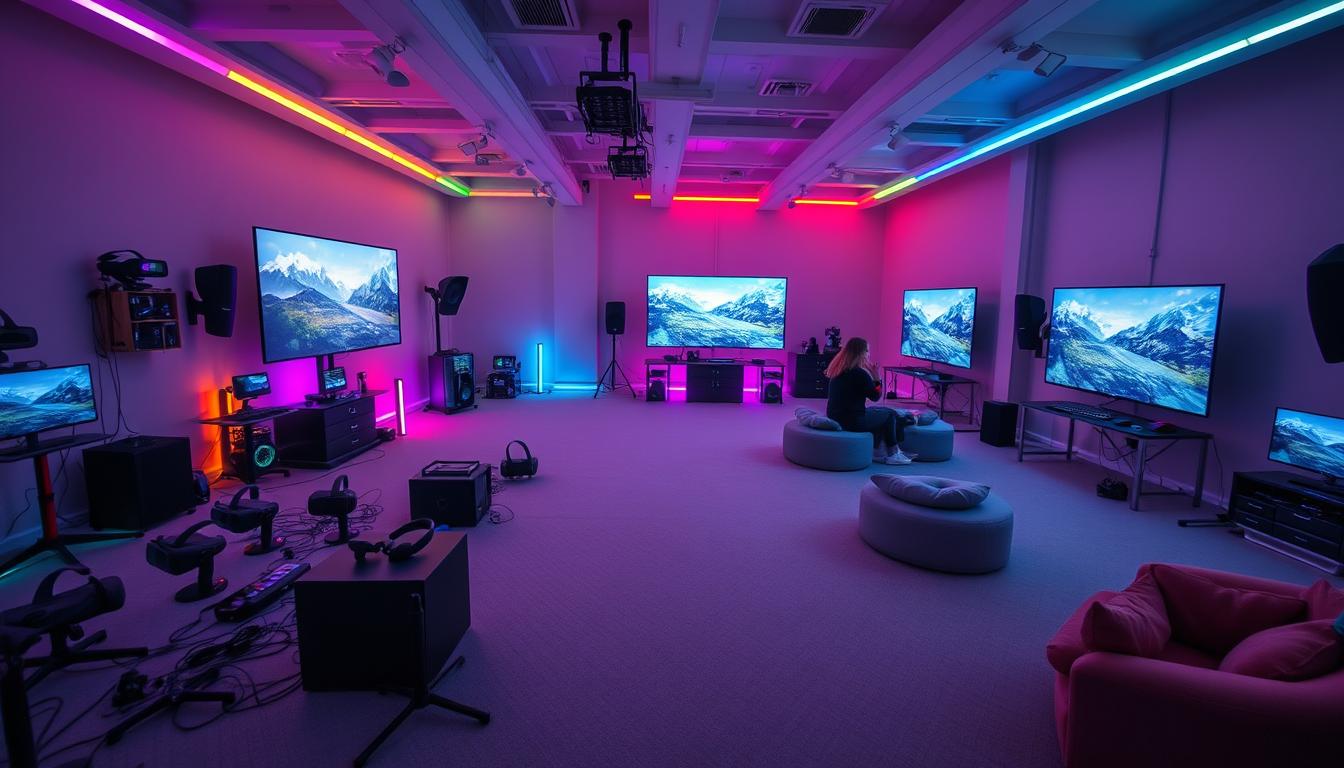Setting up a multi-user VR gaming space can be tricky. But with the right steps, it can be very rewarding. It’s important to pick the right VR headsets, like those that support up to 4 players at once1. You also need to set up your network right for online play1.
Knowing the costs for VR gear and software is also key2. A good multi-user VR setup offers a deep, real-like experience2. To get this, you need the right headsets, enough space, and the right hardware. Unity’s VR Multiplayer Project Template is a big help, supporting many VR platforms, including Meta Quest models3.
Setting up a multi-user VR space involves many things. You need the right room size and safety measures. Also, you need strong PCs and VR-ready graphics cards for a smooth experience2. Using Unity’s VR Multiplayer Project Template can make things easier3.
Key Takeaways
- Choose the right VR headsets, considering factors such as compatibility and cross-platform play, to ensure a smooth multi-user VR experience.
- Consider the space requirements, including the need for a room free from obstacles, to ensure optimal motion tracking and safety.
- Select the appropriate hardware, including high-performance PCs and VR-ready graphics cards, to support the multi-user VR experience.
- Understand the importance of proper network configuration and online connections for a seamless multi-user VR experience.
- Utilize Unity’s VR Multiplayer Project Template to streamline the development process and support various VR platforms.
- Ensure safety precautions, such as having a spotter and a virtual boundary system, to mitigate risks associated with reality disconnection2.
- Optimize the multi-user VR experience by considering factors such as latency, lag reduction, and game selection1.
Introduction
The rise of virtual reality (VR) gaming has been amazing. More people are choosing VR for fun and interactive games. Social interaction in VR makes games better and brings people together. About 60% of users like playing with others in VR4.
Multi-user VR lets players meet in a shared world. This makes games more fun, with up to 40% more fun than playing alone4. The social VR market is expected to grow fast, at 30% each year from 2023 to 20304. Some great things about playing with others in VR include:
- More people keep playing because they can play with friends
- More fun and participation because players can share their own content
- Work gets better because people can talk and work together in real time
Good strategies can keep players from leaving, cutting down drop-off rates by up to 50%4. Adding augmented reality (AR) to VR makes games 20% more enjoyable4. As VR gaming gets more popular, making good multi-user VR setups is key.
Understanding VR’s benefits and challenges helps gamers and developers. They can make VR gaming more fun and social5.
1. Choosing the Right VR Headsets
Setting up a multi-user VR gaming space starts with picking the right VR headsets. There are two main types: standalone and PC-connected. Standalone headsets, like the Meta Quest 2, cost around $300 and work alone6. PC-connected headsets, such as the HTC Vive Pro, need a powerful PC and can cost over $1,0006.
When choosing, think about compatibility and cross-platform play. This ensures all players can work together smoothly. For example, the Oculus Quest 2 is great for beginners with a wide game selection7. PC-connected headsets like the HTC Vive offer top-notch VR for those with gaming PCs7.
Important factors include the field of view and internet connection. The field of view should be at least 100º for a full experience6. A fast, reliable internet, like fiber, is needed for streaming high-quality VR video6. By focusing on these, you can make a fun and seamless VR gaming space for everyone.

These headsets come with different features and prices. They fit various users and gaming needs. By picking the right headsets and thinking about compatibility, you can make a great VR gaming space7.
2. Space Requirements and Setup
Setting up a VR gaming space for many users needs careful planning. The room should be at least 6.5 by 6 feet (78 square feet) to avoid tripping8. This size is key for room-scale VR, where players move around a lot.
Stationary VR can work in a smaller area. But, players need enough room to sit or stand comfortably. It’s also important to manage cables well and keep players aware of their surroundings8.
Some important things to think about include:
* Making sure there’s enough room above players’ heads
* Placing base stations 16 feet apart, at opposite corners of the room8
* Using good sound systems or headphones for a better experience
* Keeping cables tidy to avoid tripping hazards8
By thinking about these points and taking safety steps, you can make a fun and safe VR gaming space for everyone8.
| Room Size | VR Type | Safety Precautions |
|---|---|---|
| 6.5 x 6 feet | Room-scale VR | Proper cable management, awareness of surroundings |
| Smaller area | Stationary VR | Ensuring players have enough space to sit or stand comfortably |
3. Hardware and Performance Considerations
For a smooth VR experience, a top-notch PC is key. You need VR-ready graphics cards and processors. Also, a quick and stable internet is vital for online games, letting everyone play together in real-time9.
When picking a PC, think about these things:
- VR-ready graphics cards, like NVIDIA or AMD
- Processors with lots of cores, like Intel Core i7 or AMD Ryzen 9
- Enough RAM, at least 16 GB, for smooth play
- A fast internet, at least 100 Mbps10
A good internet setup makes VR better. With a fast PC and internet, playing games is seamless9. Remember, the PC’s performance can change with more users. Up to four can play together on one PC using virtual machines10.
In short, a top PC, VR-ready graphics, and fast internet are musts for great VR. These help users enjoy games without lag9.
| Component | Specification |
|---|---|
| Graphics Card | NVIDIA GeForce GTX 1080 |
| Processor | Intel Core i9-11900K |
| RAM | 32 GB DDR4 |
| Internet Connection | 1000 Mbps |
4. Ensuring a Smooth Multiplayer Experience
To have a smooth multiplayer experience, we need to focus on low latency and lag reduction. Research shows that direct communication between users boosts social and emotional experiences11. This is key in multiplayer gaming, where fast action is vital. It’s important to pick games that are made for playing together, with features like low latency and lag reduction.
Popular multiplayer games offer fun activities like cooperative missions and team-based combat12. These games need top-notch hardware and fast internet to work well. Also, picking the right game is key. A good game choice makes the experience better for everyone.
For multiplayer gaming, low latency and lag reduction are must-haves for fast action13. Using the best hardware and internet settings helps a lot. Also, choosing games that are made for playing together is important. This ensures a smooth and fun experience for all players.

In short, for a smooth multiplayer experience, we must think about low latency, lag reduction, and game choice. By picking the right hardware, setting up our internet well, and choosing the right games, we can have a great time playing together.
| Factor | Importance |
|---|---|
| Low Latency | High |
| Lag Reduction | High |
| Game Selection | Medium |
5. Wireless VR vs. Tethered Setup
Choosing between wireless and tethered VR setups is key for a multi-user space. Wireless VR lets you move freely but might face interference and delay14. Tethered VR gives a steady connection but limits your movement.
For tethered VR, keeping cables tidy is vital to avoid tripping15. Use cable ties, organizers, or a full system to manage cables.
Here are some points to consider:
- Wireless VR: offers more freedom but might face interference and delay14
- Tethered VR: provides a stable connection but limits movement and needs good cable management15
Wireless VR needs lots of bandwidth, up to 2400 Mbps with Wi-Fi 6E or Wi-Fi 614. Tethered VR uses USB 3.0 or higher for at least 5 Gbps (5000 Mbps)14.

The choice between wireless and tethered VR depends on what users need. Weighing the pros and cons and managing cables well can make VR fun and immersive15.
| Setup Type | Pros | Cons |
|---|---|---|
| Wireless VR | Greater freedom of movement | Prone to interference and latency |
| Tethered VR | More stable connection | Restrictive in terms of movement, requires cable management |
6. Optimizing Tracking and Sensor Placement
For a great VR experience, it’s key to set up tracking and sensors right. You can choose inside-out or external tracking. Inside-out uses cameras in the headset, while external uses room cameras8. A good VR room size is about 6.5 feet by 6.5 feet for safe play8.
When setting up a VR room, think about the space you need. Standing VR needs 1 x 1 m, while room-scale VR needs 2.5 x 2.5 m16. Also, place base stations about 2 meters high from the ground16.
High-quality tracking systems and careful sensor placement are vital. Avoiding reflective surfaces helps prevent tracking problems8. This way, you get a better VR experience.
![]()
Some VR headsets, like the Oculus Quest 2, use inside-out tracking8. But, external tracking can offer better accuracy and movement. Choose the right tracking for your setup and place sensors well for a smooth experience.
7. Setting Up Audio and Communication
When setting up a multi-user VR gaming space, audio and communication are key. The best headphones for VR offer immersive sound and clear talk. This lets players talk to each other in real-time. Studies show that good audio and chat can make gaming better, with17 VR being very good at this.
Voice chat solutions are vital for talking. They let players chat through voice, making the game feel more real. Discord and TeamSpeak are popular because they have low latency and great sound, perfect for VR gaming18. When picking chat solutions, think about latency, sound quality, and how easy it is to use.
Here are some key things to think about for audio and chat in VR gaming:
- Choose the best headphones for VR that provide immersive audio and clear communication.
- Select a reliable voice chat solution that offers low latency and high-quality audio.
- Consider the number of players and the size of the gaming space when setting up audio and communication.
Good audio and chat make VR gaming more fun and engaging. With the right gear and chat tools, VR gaming is a blast for everyone17.
| Audio and Communication Equipment | Description |
|---|---|
| Best Headphones for VR | Provide immersive audio and clear communication |
| Voice Chat Solutions | Enable players to interact with each other in real-time |
8. Multiplayer Gaming Platforms and Software
Multiplayer gaming platforms are key for a multi-user VR gaming space. They offer social VR, competitive gaming, and cloud VR. Oculus and Viveport are great for social VR, while Steam and Origin are best for competitive games19.
These platforms support cloud VR, letting players play together from anywhere. This makes remote multiplayer gaming possible, connecting players worldwide11. For example, research on VR gaming shows cloud VR’s role in improving multiplayer games.
These platforms offer social VR, competitive gaming, and cloud VR. They are perfect for multi-user VR gaming spaces19.
Social VR and competitive gaming each have their own benefits and downsides. Social VR is about socializing and building communities. Competitive gaming is about competing and showing off skills11. The choice between them depends on what users want.
9. Enhancing the Experience with Accessories
Accessories are key to a better VR experience. Virtual reality technology has grown a lot. Haptic feedback and motion controllers make a big difference. They let you feel things and move around easily20.
VR treadmills and things like VR gloves and suits also help. They let you move and act in the virtual world like you’re really there. Studies show 72% of users feel more real in high-immersion VR setups21.
When picking accessories, think about if they work with your device, how easy they are to use, and how much they cost. With more mobile VR devices, it’s easier for people to get into VR20. Also, Unity helps make and share VR games and content on many platforms20.
In short, things like haptic feedback, motion controllers, and VR treadmills make VR better. By looking at things like how well they work and their price, you can find the best ones for you21.
10. Maintenance and Future Upgrades
To keep your VR experience great, do regular maintenance on your VR gear22. Update drivers, clean your gear, and check for software updates. Also, make sure your VR setup can grow with new tech22.
Think about making your VR setup ready for new tech. Make sure it works with future VR and can grow easily22. Also, know the basics like needing an Intel Core i5-4590 or AMD FX 8350 for the processor, and a NVIDIA GeForce GTX 970 4GB or AMD Radeon R9 290 4GB for graphics22.
Regular maintenance and future upgrades stop problems with your VR. This keeps your gaming smooth. Stay current with VR tech and maintain well for a top-notch VR experience22.
Conclusion
The future of multi-user VR gaming is exciting. It’s expected to grow fast, with a 36.8% CAGR from 2021 to 202623. By 2024, 171 million people will be using VR23. More people want to play together, with 66% preferring multi-user games23.
VR developers are keeping up by updating games based on what users say. This is done by 75% of popular VR apps23. Using content made by users and social media can also help a lot. It can make users stay longer, up to 50% more in some cases23.
VR developers can make users happier by 25% by using data23. They can also get more downloads, up to 40% more23.
Keeping VR safe and private is very important. 70% of users will leave if their data is not safe23. Hosting virtual events and promotions can also help a lot. It can make users play more, up to 60% more23.
The Unity game engine is a big player in VR game development, with over 50% market share24. This means a bright future for multi-user VR gaming. Developers can make amazing games using Unity. They can overcome current VR limits and reach more users, changing how we connect in virtual worlds24.
FAQ
What are the main types of VR headsets for a multi-user setup?
What are the space requirements for a multi-user VR gaming setup?
What kind of hardware and performance considerations are important for a multi-user VR setup?
How can you ensure a smooth multiplayer experience in a multi-user VR setup?
What are the considerations for choosing between a wireless or tethered VR setup?
How can you optimize tracking and sensor placement for a multi-user VR setup?
What are the best audio and communication solutions for a multi-user VR setup?
What are the popular multiplayer gaming platforms and software options for a multi-user VR setup?
What accessories can enhance the multi-user VR gaming experience?
How can you maintain and future-proof a multi-user VR setup?
Source Links
- How can we set up Multiplayer for a VR game – https://forums.unrealengine.com/t/how-can-we-set-up-multiplayer-for-a-vr-game/256139
- How Do I Set Up a Virtual Reality Lab? – https://www.worldviz.com/post/how-do-i-set-up-a-virtual-reality-lab-2024
- VR Multiplayer Template Quick Start Guide | VR Multiplayer – https://docs.unity3d.com/Packages/com.unity.template.vr-multiplayer@2.0/manual/index.html
- Implementing Multi-user Interactivity in VR: A Developer’s Guide -Part I – https://www.linkedin.com/pulse/implementing-multi-user-interactivity-vr-developers-guide-part
- How can we set up Multiplayer for a VR game? – https://forums.unrealengine.com/t/how-can-we-set-up-multiplayer-for-a-vr-game/489821
- Choosing the Right VR Headset | Fast Feed – https://blog.frontier.com/2022/07/choosing-the-right-vr-headset/
- A Beginner’s Guide to VR: Getting Started and Finding the Right Games – https://megarealmvr.com/blog/2024/11/a-beginners-guide-to-vr-getting-started-and-finding-the-right-games/
- How to Build the Best VR Gaming Setup for Your Room? – https://www.autonomous.ai/ourblog/build-the-best-vr-gaming-setup
- Implementing Multi-user Interactivity in VR: A Developer’s Guide -Part II – https://www.linkedin.com/pulse/implementing-multi-user-interactivity-vr-developers-guide-part-1f
- Multi-headed VMWare Gaming Setup – https://www.pugetsystems.com/labs/articles/multi-headed-vmware-gaming-setup-564/?srsltid=AfmBOoozjUFdGU2WE6aMHbacYJzKMGh1nXAgD3g8avz8SrNTpQp9_Ehm
- Creating an Immersive Virtual Reality Game Space for Multiuser, Synchronous Co-Located Collaboration: Design Considerations and Influencing Factors – https://www.mdpi.com/2076-3417/14/5/2167
- FAQ | Virtual Ventures VR Game Center – https://www.virtualventuresqc.com/faq.html
- PDF – https://www.diva-portal.org/smash/get/diva2:1440801/FULLTEXT01.pdf
- Wi-Fi for Wireless VR 101: A Solid Guide | Dong Knows Tech – https://dongknows.com/wi-fi-for-wireless-vr-bandwidth-guide/
- How would you build the ultimate VR room for right now? – https://ask.metafilter.com/320934/How-would-you-build-the-ultimate-VR-room-for-right-now
- Setting up a VR space – https://unboundxr.eu/blogs/set-up-vr-space?srsltid=AfmBOopckYPhuwefHV42CQM2n9nLfQhn12KyWhWL-gaO98irgypK5Agy
- How Do I Set Up a Virtual Reality Lab? – https://www.worldviz.com/post/how-do-i-set-up-a-virtual-reality-lab
- Content Moderation in Multi-User Immersive Experiences: AR/VR and the Future of Online Speech – https://itif.org/publications/2022/02/28/content-moderation-multi-user-immersive-experiences-arvr-and-future-online/
- Starting a Virtual Reality Arcade – https://unboundxr.eu/blogs/guide-to-starting-a-vr-arcade?srsltid=AfmBOorToRPQdecK6786mDJC9JQVXB0_ABOrOGyyXmVnPM4OtrxRDZYZ
- What Is Virtual Reality? Everything You Need to Know | Simplilearn – https://www.simplilearn.com/tutorials/artificial-intelligence-tutorial/what-is-virtual-reality
- Immerse Yourself in Virtual Reality – The Future Now – https://www.lenovo.com/us/en/glossary/virtual-reality/?srsltid=AfmBOoo9rVAdluRr62DfcYPAZurbpL0j24L9ouuewMxkRZY2db_3UCnR
- Ensure Your PC is VR-Ready: Minimum Specs Checklist | TrainBeyond – https://www.trainbeyond.com/ensure-your-pc-is-vr-ready-minimum-specs-checklist/
- Implementing Multi-user Interactivity in VR: A Developer’s Guide -Part III – https://medium.com/@znanyevirtualreality/implementing-multi-user-interactivity-in-vr-a-developers-guide-part-iii-31010dbfed3d
- PDF – https://www.cse.unr.edu/~fredh/papers/conf/200-auffmuvre/paper-submitted.pdf
